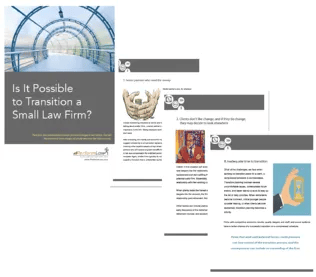While transition or succession planning is on the minds of most law firm partners and their clients, the majority of law firms avoid conversations about transition planning and partner retirement. If a law firm puts deliberate efforts into transition planning, it will have more control of its future and be able to sustain its profitability and longevity.
Law firms need to make transition planning a systematic process that applies to all attorneys. One way to do this is through the development of work-life timelines for all attorneys within ten years of retirement age. Work-life timelines show the future capability and capacity of a law firm.
Preparing work-life timelines in advance forces aging partners to consider their successors. In our experience, introducing replacement lawyers into a client account at least three years before a partner's retirement can improve client retention probability. We have found that most attorneys seriously consider retirement between the ages of 68 and 70.
Practice areas are more likely to survive over a longer continuum than many client relationships. For this reason, transition planning ten years before an actual retirement is conceptual and primarily focused on the sustainability of the skill sets in any affected practice areas.
Choosing a successor from an existing account team seems logical, but is not always an optimal choice. In many instances, loyalty and emotional attachment can influence the judgment of the retiring partner. Law firm management teams can struggle to find a voice in these situations. The retiring partner may feel that a loyal and hardworking member of the account team deserves an opportunity to assume the lead role, which works if this person is the best choice.
Most small and mid-sized firms have a non-interventionist policy regarding partner and client relationships, and it's hard to insert a successor lawyer into a client account without the full support of the retiring partner and key members the account team. As we have had better success with incentives rather than penalties, we recommend approaches that encourage (incentives) retiring partner cooperation.
Capacity planning that includes a consideration of skill and experience levels is an essential element of any transition plan. The items considered in a capacity plan include the following:
- Age;
- Experience;
- Unique skillsets;
- Billable hours targets ;
- Skill development needs;
- Marketing goals;
- Bar and professional goals;
- Pro Bono commitments;
- Recruiting responsibilities; and
- Administrative contributions.
These analyses are prepared, as relevant, at the firm, section, practice level or by strategic grouping. For example, by client team or even by skill sets.
Capacity planning is inexpensive but curing the indicated weaknesses typically comes at a cost. For example, hiring in advance of the need to allow for training can run into six figures during the ramp-up period. Several benefits and risks come with this approach to capability and capacity management including:
Benefits:
- Enables transition planning;
- Guards against turnover;
- Can contribute to the competitiveness of the firm;
- Can create competitive peer pressure;
- Helps ensure high client service levels; and
- Can maximize profitability when work surges.
Risks:
- Financial risk;
- People don't always work out;
- Excess capacity can impact the productivity of others;
- Training objectives not achieved;
- Clients may not cooperate;
- Potential compensation implications; and
- Partners who do not directly benefit may lose patience with the process.
Assuming a firm can get comfortable with the risks, staffing in advance of demand is a useful tool in transition readiness.
STRATEGIC STAFFING
Another element of capability and capacity management is the concept of strategic staffing. This staffing approach seeks to align case assignments with skill development or client transition objectives. For example assigning a senior associate who needs trial experience to cases that are going to trial, or working a successor lawyer into a client's most important matters. Both seem obvious, but without a written plan that identifies specific steps, these actions often don’t occur.
The largest impediment to this staffing approach is a workload imbalance (big case, new work, turnover, etc.) that causes immediate capacity needs to meet client demands. When this happens, the firm's short-term needs conflict with long-term strategic goals.
Typically, short-term priorities win. The pressure of the work and the immediate financial gains can create an overwhelming force. Unfortunately, these situations can result in unprepared associate lawyers, a weak transition posture, a bloated cost structure and a challenging HR situation.
Ensuring the long-term viability of the firm requires a more thoughtful approach to staffing and a genuine interest in the careers colleagues and co-workers. The risks to a disciplined approach to staffing are real, but the benefits can define a firm for decades.
DO YOU QUESTION IF
IT IS POSSIBLE TO TRANSITION A SMALL LAW FIRM?
This eBook Can Help
The only way to survive these challenges is to prepare for them and begin to address them now. This eBook describes some of these challenges and outlines ways to manage and overcome them. Most of all, the book calls out the importance to start the process NOW.
EBOOK:

.webp?width=124&height=108&name=PerformLaw_Logo_Experts3%20(1).webp)


